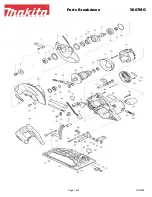
USING ACCESSORY MOULDING CUTTERHEAD
Moulding is cutting a shape on the edge of face of the work. Cutting
moulding with a moulding cutterhead in the circular saw is a fast, safe
and clean operation. The many different knife shapes available make it
possible for the operator to produce almost any kind of moulding, such
as various styles of corner moulds, picture frames, table edges, etc.
The moulding head consists of a cutterhead in which can be mounted
various shapes of steel knives,as shown in fig.12. Each of the three
knives in a set is fitted into a groove in the cutterhead and securely
clamped with a screw. The knife grooves should be kept free of sawdust
which would prevent the cutter from seating properly.
The moulding cutterhead (A) fig.13, is assembled to the saw arbor in the
same manner as the saw blade. The guard, splitter and anti-kickback
finger assembly can not be used when moulding and must be removed
from the saw as shown. Also, an optional accessory moulding cutterhead
table insert (B) Fig. 13, must be used in place of the standard table insert.
IMPORTANT: NEVER RUN THE STOCK BETWEEN THE FENCE AND
THE MOULDING CUTTERHEAD AS IRREGULAR SHAPED WOOD
WILL CAUSE KICKBACK.
When moulding end grain, the miter gauge is used. The feed should be
stowed up at the end of the cut to prevent splintering.
In all cuts, attention should be given to the grain, making the cut in the
same direction as the grain whenever possible.
ALWAYS INSTALL
BLADE GUARD AFTER OPERATION IS
COMPLETE.
USING ACCESSORY DADO HEAD
Dadoing is cutting a rabbet or a wide groove into the work. Most dado
head sets are made up of two outside blades and four or five inside
cutters, as shown in Fig. 14. Various combination of saws and cutters are
used to cut grooves from 1/8” to 13/16” for use in shelving, making joints,
tenoning, grooving, ect. The cutters are heavily swaged and must be
arranged so that this heavy portion falls in the gullet of the outside
blades, as shown in Fig. 15. The saw and cutter overlap is shown in Fig.
15 (A) being the outside blade, (B) and inside cutter, and (C) a paper
washer which can be used as needed to control the exact width of
groove. A 1/4” groove is cut by using the two outside blades. The teeth
of the blades should be positioned so that the raker on one saw is beside
the cutting teeth on the other saw.
The dado head set is assembled to the saw arbor in the same manner
as the saw blade. The guard splitter and anti-kickback finger assembly
can not be used when dadoing operations and must be removed from the
saw. Also an optional accessory dado head table insert must be used in
place of the standard table insert.
NEVER USE THE DADO HEAD IN A BEVEL POSITION!
ALWAYS INSTALL BLADE GUARD AFTER OPERATION IS
COMPLETE!
FIGURE 12
FIGURE 13
FIGURE 14
FIGURE 15
C
A
B
OPERATION





























